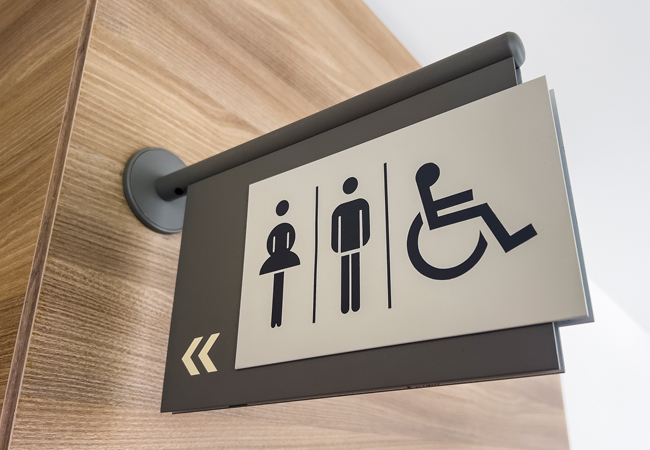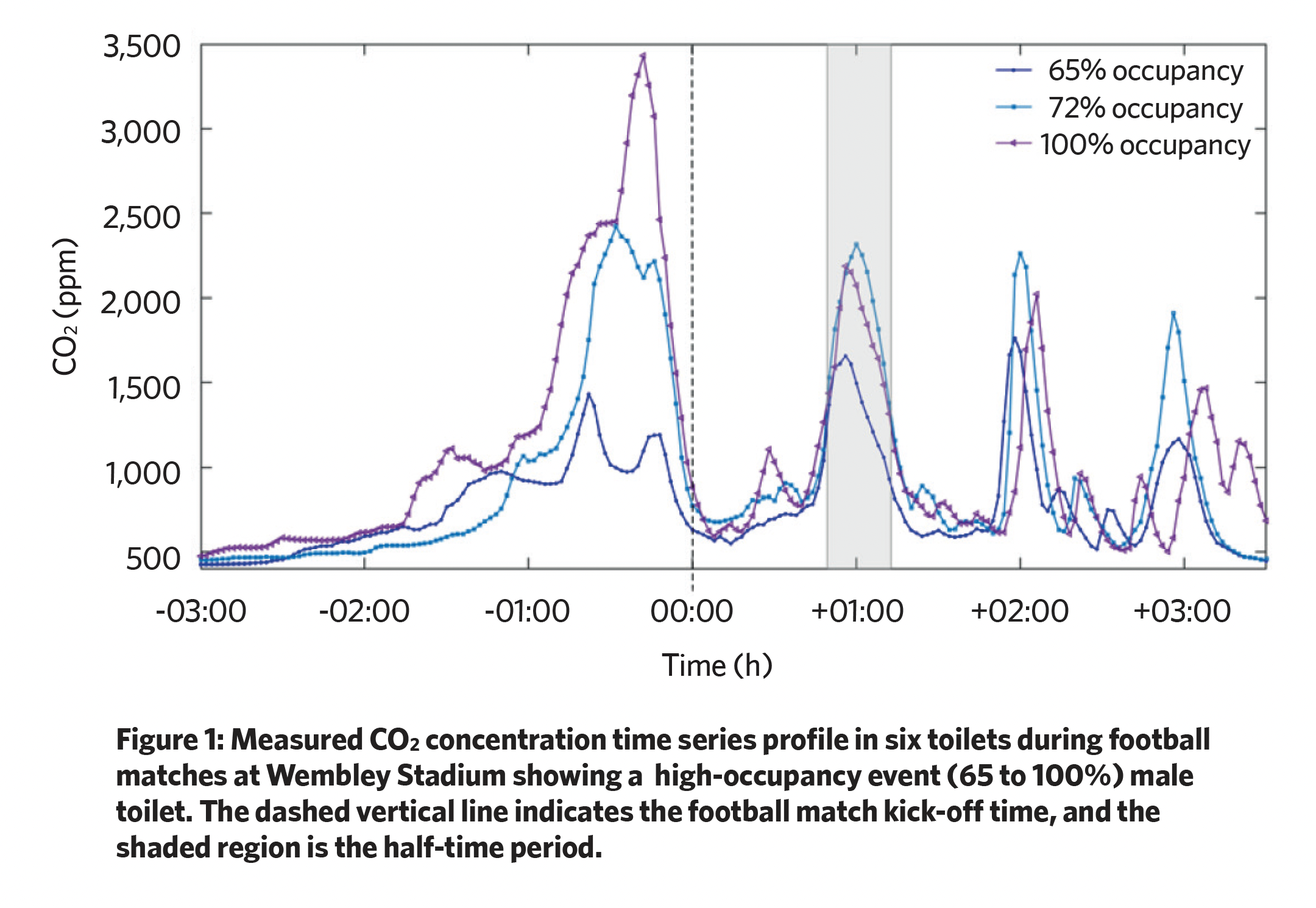
At the height of the Covid pandemic, the UK government commissioned research on the potential for Covid transmission in sports arenas and other venues attracting large crowds. The studies, carried out in 2021 as part of the Events Research Programme, aimed to establish whether it was safe to lift restrictions at mass-gathering events.
Ventilation and air quality was monitored at Wembley Stadium in London, the Crucible Theatre in Sheffield, and the O2 Arena in London, including bars, arrival/departure areas and toilets. Researchers measured the CO2 concentration as a proxy for ventilation effectiveness.
Toilets (sanitary accommodation) were identified as an area of potential high risk for the transmission of airborne pathogens1, because they are densely and continuously occupied for short durations throughout events, such as
theatre intervals, half-time at sports matches or just after the event finishes. This increases the risk of both short-range and long-range airborne transmission2.
The authors
This is a summary of conference paper Measurement of ventilation effectiveness and indoor air quality in toilets at mass gathering events presented at the AIVC Conference in Copenhagen, Denmark
The authors are: Ben Roberts and Malcolm Cook, Loughborough University; Filipa Adzic, Liora Malki-Epshtein and Chris Iddon, Department of Civil, Environmental and Geomatic Engineering at UCL; E. Abigail Hathway, Department of Civil and Structural Engineering University of Sheffield; and Benjamin Jones, the Department of Architecture and Built Environment at University of Nottingham
Results showed that while the average air quality in toilets was good at most events, there were peaks in CO2 concentration of up to 3,431ppm when occupancy was presumed high. This indicates that the risk of exposure to exhaled breath, which may contain virus-laden aerosols, is higher in toilets (although occupancy is much lower).
Person-to-person transmission of pathogens is compounded in toilets by faecal particles entering the air by flushing toilets (Best et al, 2012; Cai et al, 2022; Knowlton et al, 2018). A possible faecal-oral SARS-CoV-2 transmission route has been identified (Guo et al, 2021) leading to toilets being considered a contact hub for community transmission of SARS-CoV-2 (Dancer et al, 2021).
Ventilation that introduces uncontaminated air into a space is an important mechanism to reduce long-range transmission of airborne pathogens, but in transiently occupied spaces the ventilation rates may not be adequate to introduce enough uncontaminated air during the brief period of dense occupancy to dilute or remove airborne pathogens (Dancer et al, 2021).
The aim of the work reported in this paper was to measure the ventilation effectiveness of outdoor air in toilets at
mass gatherings.
The research
The concentration of CO2 in the indoor air was measured in 11 toilets at three different venues at 58 live events (Table 1).
A snooker match at the Crucible Theatre and a football fixture at Wembley Stadium were played in two halves. This meant there were three periods when toilets were densely occupied – pre-event, mid-event interval, and post-event – although attendees were able to occupy the toilet at any time during the event.
The Brit Awards event at the O2 Arena was televised, with frequent advertisement breaks of up to 15 minutes when presenters and performers were not on stage. It was at these times that people were most likely to leave the auditorium to use the toilets, which were all mechanically ventilated.
CO2 concentration was measured at two-minute intervals using non-dispersive infrared sensors (400-5,000ppm; ±30ppm) (Malki-Epshtein et al, 2023). The sensors (typically one or two in each toilet) were placed on walls at 1.6m to 2.3m above the floor, and away from vents, doors, or windows.
CO2 concentrations are of interest because elevations above typical ambient levels (420-500ppm) indicate exposure to exhaled breath, in the absence of other sources.
The higher the concentration of CO2 above typical ambient levels, the higher proportion of indoor air that has been exhaled by the occupants of the space. CO2 concentration alone does not indicate a risk of transmission of airborne pathogens (Iddon et al, 2022; Jones et al, 2021), but it does allow for the rapid assessment of ventilation effectiveness relative to occupancy levels.
Measurement of CO2 concentration, therefore, indicates the amount of ventilation of outdoor air being received in a space relative to the occupancy levels.
Key recommendations
- Increase the ventilation rates or the room volume in toilets that are expected to be most frequently visited.
- Increase the number of intervals, or their length, where possible, to spread out the occupancy of toilets over a longer period.
- Increase the number of toilets available, to reduce crowding, and group them in places of high occupant density.
- Change the admittance gender for some toilets if there is a predominantly male or female audience at a particular event.
- Consider where supply air to toilets is being drawn from, and avoid doing this from densely occupied adjacent spaces.
Air quality classifications were used to classify each toilet by the measured mean average and maximum CO2 concentration during each event. Average CO2 concentration was both the temporal and spatial average, whereas maximum CO2 was the single point in time with the highest CO2 concentration measured at one particular sensor location in the space.
Each space was assigned a band, from Band A (high ventilation relative to the occupancy) to Band G (low ventilation relative to the occupancy).
Results
Analysing the average CO2 concentration showed that the majority of toilets (96%) were in air quality bands A and B (400-800ppm) with the remainder (4%) in bands C and D (800-1,200ppm). For maximum CO2 concentrations, however, air quality bands in toilets were in bands A and B for fewer events (76%), and while some toilets in some events were classified as Band E, Band F, and Band G (more than 1,200ppm), they were relatively small in number (5% of events). This indicates that ventilation was generally sufficient given the occupancy levels in most toilets.

A higher proportion of toilets are in air quality of more than 1,200ppm when classifying using maximum CO2 concentration rather than when using average CO2 concentration. This indicates that there are peaks in concentration at specific times that are not sustained throughout the event. This is evidenced by investigating plots of CO2 concentration against time (Figure 1).
Wembley Stadium (football matches)
At Wembley, there were peaks in CO2 before an event, at half-time, and at the end of the event (Figure 1).
These peaks were most pronounced at the high-occupancy events, but were observed even when the occupancy levels were significantly lower than usual. There were higher maximum CO2 concentrations recorded during the events with higher occupancy levels.
During the 100% occupancy events, the maximum recorded CO2 concentration was 3,431ppm in the male toilet versus 1,320ppm in the female toilet. The CO2 concentration remained continuously above 1,500ppm (classed as a priority for improvement), for periods in male toilets at all the football matches where the occupancy was greater than 65% (Table 1).

Crucible Theatre
At the Crucible Theatre, three distinct peaks in CO2 concentration were observed. These corresponded to the event starting, during the interval, and at the end of the event.
Higher maximum and baseline CO2 concentrations were observed in three toilets, which were located close to the main theatre auditorium entrance and were the most visited.
Average CO2 concentrations in toilets close to the main auditorium entrance (first floor) were at least 32% higher than average concentrations in toilets on the ground and second floors.
It was observed that CO2 concentrations in the three toilets did not fall below 600ppm, even during periods assumed to be unoccupied. This is because extractor fans drew air through toilet-door grilles from densely occupied adjacent spaces.
O2 arena (Brit Awards)
The music awards ceremony at the O2 arena did not have a specific half-time interval. Instead, there were a series of 15-minute advert/commercial breaks because the show was televised.
Toilet visits were more evenly spaced and this is reflected in the flatter CO2 concentration profile. Despite the significantly reduced occupancy (18% of usual capacity), the female toilet on Level 1 reached a maximum CO2 concentration of 1,169ppm and was sustained above 1,000ppm for more than two hours.
The male toilets, located just next to the female toilets on Level 1, presented with a peak CO2 concentration of 1,100ppm just before the event started, but fell to an average below 750ppm during the show. Nonetheless, the CO2 concentrations recorded inside the toilets were considerably higher than those immediately outside.
Effect of occupancy levels
It has been shown that higher occupancy levels drive an increase in CO2 concentration, as this is the only significant factor believed to change between events (the ventilation systems were otherwise operated identically).
At the Crucible Theatre, the effect of occupancy on maximum CO2 concentration is apparent in all toilets, but especially those visited frequently.
At low occupancy events – for example, around 10% – all maximum CO2 concentrations were below 800ppm, but the trend line indicates maximum CO2 of more than 2,000ppm might be expected in some toilets at fully occupied events.
Conclusions
The measurement of CO2 concentration in indoor air does not indicate the risk of long-range transmission of airborne pathogens, but it is a useful way of rapidly assessing the level of ventilation relative to the occupancy of a particular space.
Most of the toilets were deemed to be sufficiently ventilated, but a small number were targeted for improvement using the maximum CO2 concentration as a performance metric.
The proximity of the toilet to important areas in each venue was a key indicator of performance. This perhaps suggests the ventilation systems in these toilets were undersized and unable to cope with the short periods of very high occupancy.
Venue operators should consider ways to better disperse the event attendees around the various toilets in the venue, to avoid overcrowding in any particular toilet. At the Crucible Theatre, for example, venue operators changed some toilets to unisex to reduce overcrowding in the male toilets.
The mean average CO2 concentration in 11 toilets was indicative of ventilation that was sufficient relative to the occupancy levels at 96% of the 58 events.
Investigation of the maximum CO2 concentrations, however, showed that, at some events, there were intermittent periods of high CO2, which indicated poor ventilation relative to the number of occupants. This mainly occurred during half-time intervals at the snooker and football matches, particularly during the higher-occupancy events, and in toilets closest to auditorium entrances.
Key recommendations have been made in the paper (see panel, ‘Key recommendations’ on p55), including increasing ventilation rates, ensuring supply air is from areas with low occupancy, and allowing different genders to use the same toilets if there is a predominantly male or female audience.
References:
- Dancer et al, 2021; Malki-Epshtein et al, 2023
- Adzic et al, 2022
- The CO2 monitoring study was funded by the Department for Digital, Culture, Media, & Sport, which arranged access to the venues and events. The subsequent analysis was carried out by the Airborne Infection Reduction through Building Operation and Design for SARS-CoV-2 (AIRBODS) consortium, funded by the Engineering and Physical Sciences Research Council (EPSRC) grant.

